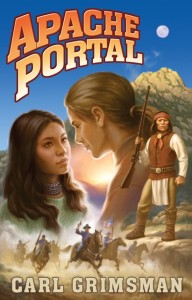 Were there ever fires as these in the days of the Apache?
Were there ever fires as these in the days of the Apache?
During the summer of 2011, as I planned my first research trip to Cochise County, Arizona, for my upcoming novel APACHE PORTAL, three wildfires raged out of control across the historic Apache homeland.
The largest ended up burning 530,000 acres of what is now the the Apache-Sitgreaves National Forest. The second attacked the Chiricahua Mountains, setting 220,000 acres of that vast “sky island” ablaze. The third fire charred over 30,000 acres in the Coronado National Monument area near Sierra Vista.
All together these fires consumed 1200 square miles of pinon pine, juniper, and ponderosa pine, an area the size of Rhode Island. Thankfully the woodlands are now recovering, but when my companion and I visited the Chiricahua mountains a few months later, in the fall of 2011, the land still bore an eerie air of devastation.
 The park service had just reopened the Chiricahua National Monument section, but the route to the main overlook was off limits due to burned-off guardrail posts on the narrow mountain road. We were permitted to pull into the first picnic area, and from there traverse one of the hiking trails.
The park service had just reopened the Chiricahua National Monument section, but the route to the main overlook was off limits due to burned-off guardrail posts on the narrow mountain road. We were permitted to pull into the first picnic area, and from there traverse one of the hiking trails.
A pipe-organ-like array of the range’s unique chimney rocks greeted us early into our walk. This type of spire formation is featured in wide panoramas further into the mountains where we could not go on this autumn day, where the Apache camped, hunted, and in bygone times eluded the U.S. Army.
The thick woods where the Apache and more recently the deer and bear had roamed was now bare hillsides and valleys.

 A rock-colored lizard greeted us, as if to say, “I’m still here.”
A rock-colored lizard greeted us, as if to say, “I’m still here.”
 Back at the picnic area we ate lunch while Mexican bluejays squawked, flitted, and boldly took nuts from my fingers.
Back at the picnic area we ate lunch while Mexican bluejays squawked, flitted, and boldly took nuts from my fingers.
The Chiricahua Apache, who roamed this rocky terrain as part of their nomadic circuit from Apache Pass through northern Mexico, following the wild crops and animals, were a subset of six major branches of the Apache people: the western Apache to their north, the Mescalero to their east, and the Jicarillo, Lipan, and Kiowa Apache further to the east, some as far as what is now Texas and Oklahoma.
The Chiricahua built camps in many places, consisting of wickiups built from branches and brush. They left grinding stones each camp, and sometimes ramadas, which were outdoor shade structures for hot weather.
 The Apache liked the cool of the mountains in the summer. The mountains received more rain than the wide, grassy valleys, which ran in streams and watered the game animals and nut trees. Unless they were at peace the Apache did not camp on a stream bank or next to a spring, lest an enemy surprise them. And always, while in camp, each person knew the pre-selected rallying point some distance away, where they would meet, in case the camp was attacked.
The Apache liked the cool of the mountains in the summer. The mountains received more rain than the wide, grassy valleys, which ran in streams and watered the game animals and nut trees. Unless they were at peace the Apache did not camp on a stream bank or next to a spring, lest an enemy surprise them. And always, while in camp, each person knew the pre-selected rallying point some distance away, where they would meet, in case the camp was attacked.
The Apache fought with the Mexicans and the Americans for many decades. Apaches considered all intruders into their homeland as fair game for harvest and plunder. But later it was the Apaches who were hunted, until the civilization encroaching on every side finally overwhelmed them.
The spirit of the Chiricahua lives on in the mountains which today bear their name.
A year after our first trip to the Chiricahua National Monument, we returned for my continued research for APACHE PORTAL. This time we were able to proceed to the lookout area. Some green had reappeared, the landscape having had the benefit of two summer monsoon seasons.
 The lookout is called Massai Point. Massai was an Chiricahua warrior who was part of Geronimo’s band of renegades. When Geronimo surrendered in 1886 to end the Apache Wars, his people were loaded onto a train for imprisonment in Florida. But Massai escaped from the train and found his way back some 1200 miles to Arizona. There and in Mexico he lived out his days, hiding, taking what he needed – including a wife – his final resting place unknown.
The lookout is called Massai Point. Massai was an Chiricahua warrior who was part of Geronimo’s band of renegades. When Geronimo surrendered in 1886 to end the Apache Wars, his people were loaded onto a train for imprisonment in Florida. But Massai escaped from the train and found his way back some 1200 miles to Arizona. There and in Mexico he lived out his days, hiding, taking what he needed – including a wife – his final resting place unknown.
If you find stories of the old west fascinating, tales of Indians, cavalry, and early ranching, check out APACHE PORTAL, available in Ebook format and in paperback at Amazon.com and at quality booksellers everywhere.
This is the second in a series of articles exploring The World of APACHE PORTAL.
Photos and text Copyright 2014 Carl Grimsman, All rights reserved.





